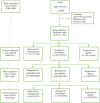Are the determinants of the progression to type 2 diabetes and regression to normoglycemia in the populations with pre-diabetes the same?
- PMID: 36277718
- PMCID: PMC9585180
- DOI: 10.3389/fendo.2022.1041808
Are the determinants of the progression to type 2 diabetes and regression to normoglycemia in the populations with pre-diabetes the same?
Abstract
Background: We aimed to determine the predictors of regression to normoglycemia and progression to diabetes among subjects with pre-diabetes in a single model concurrently.
Methods: The present study included 1329 participants aged 20 to 70 years with prediabetes from the population-based cohort of the Tehran Lipid and Glucose Study, with a 10-year follow-up. Glycemic status at follow-up was categorized as regression to normoglycemia: fasting plasma glucose [FPG] of <5.55 and 2h-plasma glucose [PG] of <7.77 mmol/L, and not taking antidiabetic medications. Glycemic status at follow-up was categorized as progression to diabetes: FPG ≥7 or 2h-PG of ≥11.1 mmol/L, or taking antidiabetic medications. Glycemic status determined whether the patients remained in prediabetes category (isolated impaired fasting glycaemia [iIFG] [(5.55≤FPG<7 and 2h-PG<7.77 mmol/L); isolated impared glucose tolarence [iIGT] (7.77 ≤ 2h-PG<11.1 and FGP<5.55 mmol/L)]. With prediabetes as a reference, multinomial logistic regression was utilized to identify the determinants of glycemic changes.
Results: Approximately 40% of participants returned to normoglycemia (n = 578), and similar percentage of participants progressed to diabetes (n = 518). Based on the multivariable multinomial model, regression to normoglycemia was associated with age (relative risk ratio [RRR] = 0.97; 95% CI, 0.95-0.99), female sex (RRR = 1.72; 95% CI, 1.18-2.50), high education level of ≥12 years (RRR = 2.10; 95% CI, 1.19-3.70), and combined IFG/impaired glucose tolerance (IGT) versus IFG (RRR = 0.45; 95% CI, 0.29-0.70). The risk of progression to diabetes increased with body mass index (RRR = 1.10; 95% CI, 1.05-1.15), waist circumference (RRR = 0.97; 95% CI, 0.96-0.99), positive familial history of diabetes (RRR = 1.62; 95% CI, 1.07-2.45), and combined IFG/IGT versus IFG (RRR = 2.54; 95% CI, 1.71-3.77).
Conclusion: A small percentage of patients with prediabetes remain in this condition, but the majority go on to develop diabetes or regress to normoglycemia. Both directions had distinct predictors.
Keywords: Cardiometabolic disorders; normoglycemia; pre-diabetes; progression; regression; type 2 diabetes.
Copyright © 2022 Alizadeh, Baradaran, Kohansal, Hadaegh, Azizi and Khalili.
Conflict of interest statement
The authors declare that the research was conducted in the absence of any commercial or financial relationships that could be construed as a potential conflict of interest.
Figures
Similar articles
-
Determinants of the progression to type 2 diabetes and regression to normoglycemia in people with pre-diabetes: A population-based cohort study over ten years.Prim Care Diabetes. 2022 Dec;16(6):797-803. doi: 10.1016/j.pcd.2022.10.002. Epub 2022 Oct 28. Prim Care Diabetes. 2022. PMID: 36404444
-
Identification of impaired fasting glucose, healthcare utilization and progression to diabetes in the UK using the Clinical Practice Research Datalink (CPRD).Pharmacoepidemiol Drug Saf. 2016 Dec;25(12):1375-1386. doi: 10.1002/pds.4007. Epub 2016 May 19. Pharmacoepidemiol Drug Saf. 2016. PMID: 27193175
-
The association of body weight change and regression to normoglycemia in different phenotypes of pre-diabetes: Findings of a longitudinal cohort study.Clin Nutr ESPEN. 2024 Oct;63:887-892. doi: 10.1016/j.clnesp.2024.08.024. Epub 2024 Aug 28. Clin Nutr ESPEN. 2024. PMID: 39214244
-
Identification and treatment of prediabetes to prevent progression to type 2 diabetes.Clin Cornerstone. 2007;8(2):10-8; discussion 19-20. doi: 10.1016/s1098-3597(09)60004-1. Clin Cornerstone. 2007. PMID: 18357952 Review.
-
Oral antidiabetic drugs and regression from prediabetes to normoglycemia: a meta-analysis.Ann Pharmacother. 2012 Apr;46(4):469-76. doi: 10.1345/aph.1Q554. Epub 2012 Apr 3. Ann Pharmacother. 2012. PMID: 22474136 Review.
Cited by
-
Associations between non-traditional lipid parameters and normoglycemic reversion in Chinese adults with prediabetes: a retrospective analysis.Front Endocrinol (Lausanne). 2025 Jun 24;16:1502861. doi: 10.3389/fendo.2025.1502861. eCollection 2025. Front Endocrinol (Lausanne). 2025. PMID: 40630100 Free PMC article.
-
Effect of onset of type 2 diabetes on risks of cardiovascular disease and heart failure among new Zealanders with impaired glucose tolerance over 25 years: tapered-matched landmark analysis.Cardiovasc Diabetol. 2023 Jun 30;22(1):163. doi: 10.1186/s12933-023-01871-y. Cardiovasc Diabetol. 2023. PMID: 37391762 Free PMC article.
-
Association between urinary sodium-to-potassium ratio, elevated blood pressure phenotypes and microalbuminuria: Tehran Lipid and Glucose Study.Sci Rep. 2024 Nov 11;14(1):27577. doi: 10.1038/s41598-024-79207-3. Sci Rep. 2024. PMID: 39528808 Free PMC article.
-
Total fat intake and fatty acid patterns and prediabetes regression: differential effects across phenotypes in a population-based cohort.Eur J Med Res. 2025 Feb 17;30(1):110. doi: 10.1186/s40001-025-02337-5. Eur J Med Res. 2025. PMID: 39962610 Free PMC article.
-
Nonlinear association between remnant cholesterol and reversion from impaired fasting glucose to normoglycemia: a multicenter cohort study.Lipids Health Dis. 2024 Sep 19;23(1):303. doi: 10.1186/s12944-024-02286-8. Lipids Health Dis. 2024. PMID: 39300559 Free PMC article.
References
Publication types
MeSH terms
Substances
LinkOut - more resources
Full Text Sources
Medical


